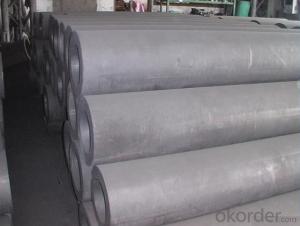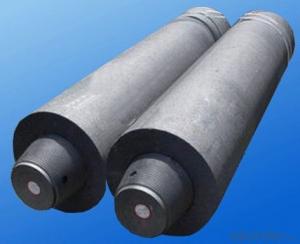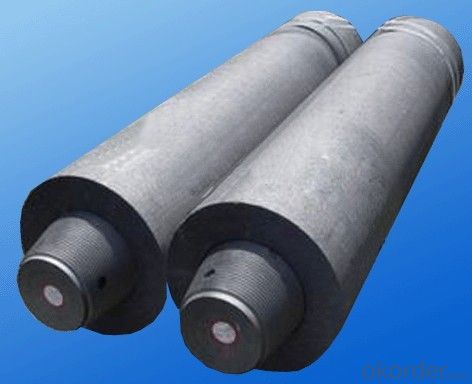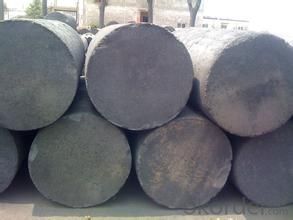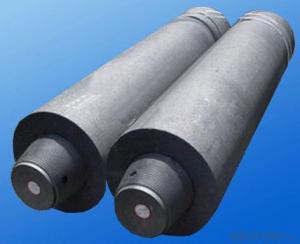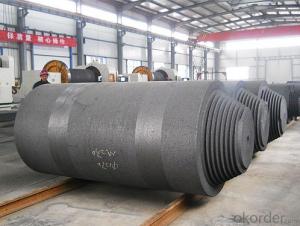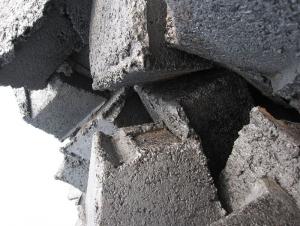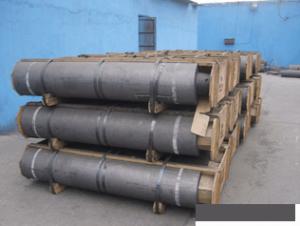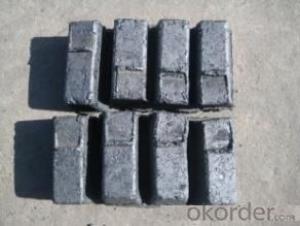Carbon Electrodes With Very Stable Quality
- Loading Port:
- Lianyungang
- Payment Terms:
- TT OR LC
- Min Order Qty:
- 20 m.t.
- Supply Capability:
- 700 m.t./month
OKorder Service Pledge
OKorder Financial Service
You Might Also Like
Carbon Electrodes With Very Stable Quality
Features
1:carbon eletrode
2:for ferroalloy,calcium carbide, silicon metal, manufacture
Graphite/Carbon Electrode Paste Specification
| PARAMETER UNIT GUARANTEE VALUE | ||||||
| Items | Φ500~Φ700 | Φ750~Φ960 | Φ1020~Φ1400 | |||
| Rs μΩ.m | ≤45 | ≤38 | ≤45 | ≤38 | ≤40 | |
| Bulk Desity g/cm3 | ≥1.55 | ≥1.58 | ≥1.55 | ≥1.58 | ≥1.55 | ≥1.58 |
| Bending Strength MPa | 3.5~7.5 | 4.0~7.5 | 3.5~7.5 | 4.0~7.5 | 3.5~7.5 | 4.0~7.5 |
| Compressive Strength MPa | ≥20.0 | ≥20.0 | ≥20.0 | ≥20.0 | ≥19.0 | ≥19.0 |
| Compressive Strength MPa | 3.2~4.8 | 3.0~4.6 | 3.2~4.8 | 3.0~4.6 | 3.2~4.8 | 3.0~4.6 |
| Ash % | ≤2.5 | ≤2.0 | ≤2.5 | ≤2.0 | ≤2.5 | ≤2.0 |
Pictures:
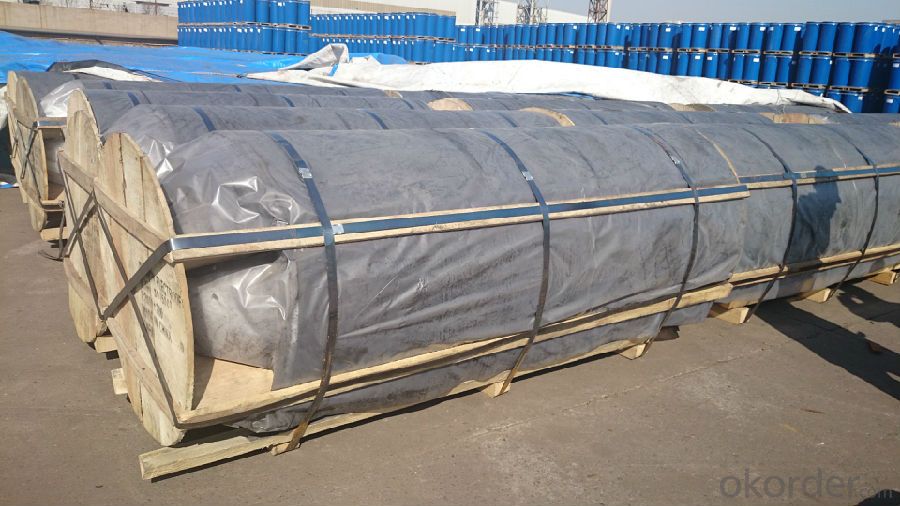
We can adjust the size based on different enquiry. please contact us if you are interested in this materials, we will send our offer as soon as get your kind email.
Do you know the use of the graphite electrode?
1, It is used for the electric arc furnace steel making. (About 70-80% graphite electrode is used for steel making).
2, It is used for the submerged arc furnace, including melting iron alloy, pure silicon, yellow phosphorus,
matte, calcium carbide and so on.
3, It is used for the resistance furnace, such as the graphite making, melting glass, silicon carbide
making and so on.
- Q: How does carbon affect the formation of tornadoes?
- Carbon does not directly affect the formation of tornadoes. Tornadoes are primarily caused by the interaction of warm, moist air from the surface and cold, dry air from the upper levels of the atmosphere, resulting in strong updrafts and rotating air columns. Carbon, as an element, does not play a significant role in this process. However, indirectly, carbon emissions and human-induced climate change can impact the overall weather patterns, including the frequency and intensity of tornadoes. Increased carbon dioxide in the atmosphere, primarily from the burning of fossil fuels, contributes to global warming. This, in turn, leads to changes in temperature and moisture patterns, which can influence the conditions conducive to tornado formation. The warming of the atmosphere due to increased carbon dioxide levels can lead to more instability in the atmosphere, creating favorable conditions for severe thunderstorms, which can spawn tornadoes. Additionally, the increased moisture content in the warmer atmosphere can provide more fuel for these storms, potentially enhancing their strength. It is important to note, however, that the relationship between carbon emissions and tornadoes is complex and still an area of ongoing research. While a connection between climate change and tornadoes is plausible, it is challenging to attribute individual tornadoes to carbon emissions alone, as tornadoes are influenced by various meteorological factors. In summary, carbon does not directly impact the formation of tornadoes, but the increased carbon emissions and resulting climate change can indirectly influence the conditions that contribute to tornado formation. Further scientific research is needed to fully understand the relationship between carbon emissions, climate change, and tornado activity.
- Q: What is carbon neutral shipping?
- Carbon neutral shipping refers to the concept of offsetting or balancing out the carbon emissions produced during the transportation of goods by sea, air, or land. It aims to minimize the negative impact of shipping on the environment and climate change. Shipping contributes to greenhouse gas emissions through the burning of fossil fuels, primarily through the use of heavy fuel oil in ships' engines. This results in the release of carbon dioxide (CO2), nitrogen oxides (NOx), sulfur oxides (SOx), and particulate matter into the atmosphere, contributing to global warming and air pollution. To achieve carbon neutrality in shipping, various strategies can be employed. One of the most common approaches is the use of carbon offsetting. This involves investing in projects that reduce or remove an equivalent amount of CO2 from the atmosphere, such as reforestation, renewable energy projects, or methane capture initiatives. By supporting these projects, the carbon emissions from shipping are balanced out, resulting in a net-zero carbon footprint. Another method to achieve carbon neutrality is through the use of alternative fuels and energy-efficient technologies. For instance, biofuels, hydrogen, and electric propulsion systems can significantly reduce or eliminate carbon emissions from ships during their operation. Additionally, optimizing shipping routes and vessel design can also contribute to reducing fuel consumption and emissions. Furthermore, collaboration between shipping companies, governments, and international organizations is essential to promote carbon neutral shipping. This includes setting industry-wide emission reduction targets, implementing stricter regulations, and providing incentives for sustainable practices. While carbon neutral shipping is a positive step towards mitigating climate change, it is important to acknowledge that it should be seen as a transitional measure towards achieving a fully decarbonized shipping sector. Continued research and development in clean technologies, along with the adoption of sustainable practices, are crucial to achieving long-term environmental sustainability in the shipping industry.
- Q: What are the effects of carbon emissions on agriculture?
- Agriculture is significantly harmed by carbon emissions, with various negative effects. Firstly, the presence of higher levels of carbon dioxide (CO2) in the atmosphere contributes to global warming, resulting in changes in rainfall patterns and more frequent occurrences of extreme weather events like droughts, floods, and heatwaves. These weather conditions disrupt agricultural production by reducing crop yields, damaging crops, and increasing the prevalence of pests and diseases. Higher temperatures also accelerate evaporation, which leads to soil moisture deficits and water scarcity. This has a detrimental impact on crop growth and productivity. Additionally, elevated CO2 levels can modify the nutritional composition of crops, reducing their quality and nutritional value. Research has demonstrated that increased CO2 concentrations can decrease the protein content in wheat and rice, potentially causing health issues for those who heavily rely on these staple crops. Moreover, carbon emissions contribute to the formation of ground-level ozone, a harmful air pollutant. Ozone damages plant cells, inhibits photosynthesis, and reduces crop yields. It particularly affects sensitive crops such as soybeans, wheat, and cotton. The consequences of carbon emissions on agriculture extend beyond crop production. Livestock farming is also affected, as rising temperatures and water scarcity make it more difficult to maintain adequate grazing lands and provide sufficient water and fodder for animals. Furthermore, changes in climate patterns can facilitate the spread of livestock diseases and pests, posing additional risks to the livestock industry. In conclusion, carbon emissions have far-reaching effects on agriculture, resulting in decreased crop yields, diminished nutritional value, challenges in livestock farming, and increased vulnerability to pests, diseases, and extreme weather events. It is crucial to address and mitigate carbon emissions to safeguard global food security and ensure the sustainability of agricultural systems.
- Q: What is the role of carbon in the formation of coal, oil, and natural gas?
- The formation of coal, oil, and natural gas relies heavily on carbon. Carbon is a crucial component of these fossil fuels, along with varying amounts of hydrogen, sulfur, nitrogen, and other elements. To begin the formation process, organic matter, such as dead plants and marine organisms, accumulates in oxygen-limited environments. Over a span of millions of years, the organic matter undergoes intense heat and pressure, resulting in a process called carbonization. During carbonization, the carbon within the organic matter undergoes chemical transformations, converting it into solid, liquid, or gaseous hydrocarbon compounds. The specific conditions under which carbonization takes place determine the specific type of fossil fuel that will be produced. In the case of coal, the organic matter primarily consists of land-based plant material. Through high pressure and temperature, carbonization converts this plant material into solid coal. The duration and intensity of the carbonization process determine the carbon content of the resulting coal. Different types of coal, such as lignite, bituminous, and anthracite, exhibit varying carbon content and energy density. Conversely, oil is formed from marine organisms like plankton and algae. As these organisms die, they descend to the ocean or lake floor and gradually become buried beneath layers of sediment. Over time, the heat and pressure cause carbonization, transforming the organic matter into a liquid hydrocarbon mixture known as crude oil. This crude oil can subsequently undergo further processing to yield various petroleum products. Natural gas, on the other hand, consists primarily of methane (CH4) and forms under similar conditions as oil. However, the carbonization process occurs at higher temperatures and pressures, leading the organic matter to decompose into gaseous hydrocarbon compounds. Natural gas can be found alongside oil deposits or trapped within underground rock formations, such as shale or sandstone. In summary, carbon serves as the essential foundation for the formation of coal, oil, and natural gas. Its presence within organic matter, combined with optimal conditions of heat, pressure, and time, culminates in the creation of these valuable energy resources that significantly contribute to powering our modern world.
- Q: How do you remove the carbon stains on your clothes?
- Can choose 120 solvent xylene, gasoline, alcohol or alcohol xylene soap, gently scrub, to color stain oil in removed and low temperature soaping. Remove paint stains difficult. The new pollution paint stains to timely, with a small brush dipped in banana water (thinner) or four carbon chloride benzene, gasoline, and other organic solvents, gently scrub fabric, and then use the low temperature washing, rinse can be. The old paint stains, first with 120 solvent gasoline soaked, the stain of the fabric and the combination of loose, banana water, benzene 46 family washing and ironing guide removal. If the white cotton polyester fabric. Stains are larger paint stains, can use low concentration of caustic soda liquid soap, soap boiling temperature, also can achieve the ideal effect. The removal ratio of lye soap is 5000 grams of water plus 100 grams of caustic soda, half soap (dissolved after heating temperature 80 to 90 DEG C), i.e. Can be.
- Q: How does carbon affect the formation of landslides?
- The formation of landslides is not directly influenced by carbon. Instead, natural factors such as heavy rainfall, earthquakes, or volcanic activity, as well as human activities like deforestation or construction, primarily trigger landslides. However, carbon does have an indirect role in landslides through its impact on the environment. The emission of excessive carbon dioxide (CO2) is primarily caused by human activities like burning fossil fuels and deforestation, and this contributes to climate change. As a result of climate change, rainfall events become more frequent and intense, increasing the likelihood of landslides. The increased rainfall saturates the soil, making it heavier and more susceptible to sliding, particularly on steep slopes. Deforestation is another way in which carbon indirectly affects landslides. Trees play a crucial role in stabilizing slopes by anchoring the soil with their root systems. However, when forests are cleared for agriculture, urbanization, or logging, the loss of tree cover weakens the soil's stability and raises the risk of landslides. Furthermore, the absence of vegetation reduces rainfall absorption, leading to increased surface runoff and erosion, further destabilizing slopes and making them more prone to landslides. In conclusion, while carbon itself does not directly cause landslides, its impact on climate change and deforestation can indirectly contribute to the occurrence and severity of landslides. Addressing carbon emissions and promoting sustainable land management practices are essential to mitigate the risk of landslides and preserve the stability of slopes.
- Q: Is carbon monoxide good for people?
- But in organ transplant operations, the use of trace amounts of carbon monoxide helps dilate blood vessels and reduce inflammation, thereby increasing the survival rate of transplanted organs. But traditional carbon monoxide inhalation has the risk of poisoning patients and medical staff by accidental inhalation of high doses of carbon monoxide. That's the advantage of CO
- Q: What are the effects of carbon emissions on human respiratory health?
- Carbon emissions can have significant negative effects on human respiratory health. One of the primary components of carbon emissions is carbon dioxide (CO2), which contributes to air pollution and climate change. High levels of carbon dioxide in the atmosphere can lead to an increase in the concentration of other pollutants such as particulate matter, nitrogen oxides, and sulfur dioxide. Exposure to these pollutants, particularly fine particulate matter (PM2.5), has been linked to a range of respiratory problems. Inhalation of PM2.5 can irritate the airways, leading to symptoms such as coughing, wheezing, and shortness of breath. It can also exacerbate existing respiratory conditions such as asthma, chronic obstructive pulmonary disease (COPD), and bronchitis. Long-term exposure to high levels of PM2.5 has been associated with the development of respiratory diseases and can contribute to increased hospital admissions and mortality rates. Furthermore, carbon emissions contribute to the formation of ground-level ozone, a harmful pollutant that is a key component of smog. Ozone can cause inflammation and damage to the respiratory system, leading to respiratory symptoms and reduced lung function. It can also worsen existing respiratory conditions and increase the risk of respiratory infections. In addition to these direct effects, carbon emissions also contribute to climate change, which has indirect impacts on respiratory health. Climate change can lead to increased heatwaves and extreme weather events, which can worsen air quality and trigger respiratory symptoms. It can also impact the distribution of allergens such as pollen, mold spores, and dust mites, increasing the prevalence of respiratory allergies and asthma. Overall, carbon emissions have significant detrimental effects on human respiratory health. They contribute to air pollution, which can cause respiratory symptoms, exacerbate existing respiratory conditions, and increase the risk of developing respiratory diseases. They also contribute to climate change, which indirectly impacts respiratory health through changes in air quality and the prevalence of allergens. Reducing carbon emissions and improving air quality is crucial for protecting and promoting respiratory health.
- Q: How can we reduce carbon emissions from transportation?
- Reducing carbon emissions from transportation is crucial to mitigate climate change and improve air quality. There are several strategies that can be implemented to achieve this goal: 1. Promote the use of electric vehicles (EVs): Encouraging the adoption of electric cars, buses, and bikes can significantly reduce carbon emissions. Governments can provide incentives such as tax credits, rebates, and subsidies to make EVs more affordable. Expanding the charging infrastructure network is also essential to alleviate range anxiety and increase EV adoption. 2. Invest in public transportation: Enhancing and expanding public transportation systems can reduce the number of individual vehicles on the road, leading to fewer emissions. Governments should prioritize the development of efficient and accessible public transport networks, including buses, trains, and trams. 3. Encourage active transportation: Encouraging walking, cycling, and other forms of active transportation can significantly reduce carbon emissions from short-distance trips. Building safe and convenient infrastructure, such as bike lanes and pedestrian-friendly streets, can promote these modes of transport. 4. Improve fuel efficiency: Encouraging the production and purchase of vehicles with higher fuel efficiency standards can greatly reduce carbon emissions. Governments should implement strict regulations and offer incentives to manufacturers that produce fuel-efficient vehicles. 5. Develop and promote alternative fuels: Investing in the development and use of alternative fuels, such as biofuels, hydrogen, and renewable natural gas, can help reduce carbon emissions from transportation. Governments should provide incentives and support research and development efforts to accelerate the adoption of these cleaner fuels. 6. Implement congestion pricing and road tolls: Charging drivers for using congested roads or entering certain areas can reduce traffic congestion and encourage the use of public transportation or carpooling. By discouraging unnecessary car trips, carbon emissions can be significantly reduced. 7. Encourage telecommuting and flexible work arrangements: Promoting telecommuting and flexible work arrangements can reduce the number of commuting trips and, consequently, carbon emissions. Governments and businesses can provide incentives to encourage companies to adopt these practices. 8. Rethink urban planning: Designing cities and communities with mixed land-use patterns, where residential, commercial, and recreational areas are within close proximity, can reduce the need for long commutes and promote active transportation. 9. Raise awareness and provide education: Educating the public about the environmental impact of transportation choices and the benefits of sustainable modes of transport is crucial. Governments and organizations should launch campaigns to raise awareness and provide information about the carbon footprint of different transportation options. Reducing carbon emissions from transportation requires a multifaceted approach involving government policies, technological advancements, and changes in individual behavior. By implementing these strategies, we can make significant progress in reducing carbon emissions and creating a more sustainable transportation system.
- Q: How is carbon used in the production of nanotubes?
- Carbon is used in the production of nanotubes by being arranged in a unique structure where carbon atoms are bonded together in a hexagonal lattice, forming a tube-like structure. This arrangement allows for the formation of nanotubes with exceptional mechanical, electrical, and thermal properties, making them ideal for various applications in fields such as electronics, materials science, and medicine.
Send your message to us
Carbon Electrodes With Very Stable Quality
- Loading Port:
- Lianyungang
- Payment Terms:
- TT OR LC
- Min Order Qty:
- 20 m.t.
- Supply Capability:
- 700 m.t./month
OKorder Service Pledge
OKorder Financial Service
Similar products
Hot products
Hot Searches
Related keywords
